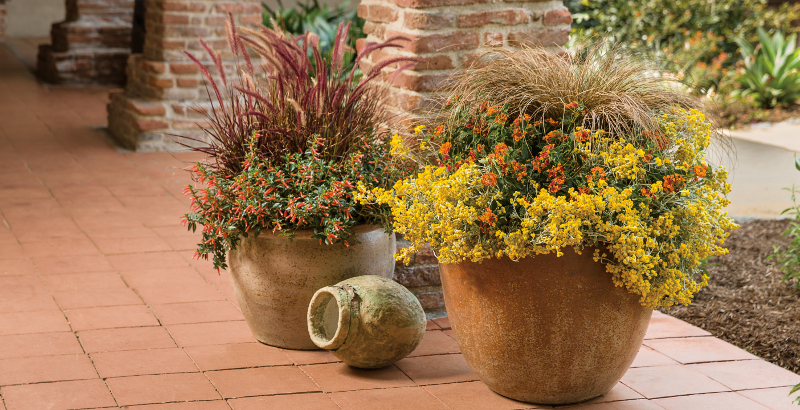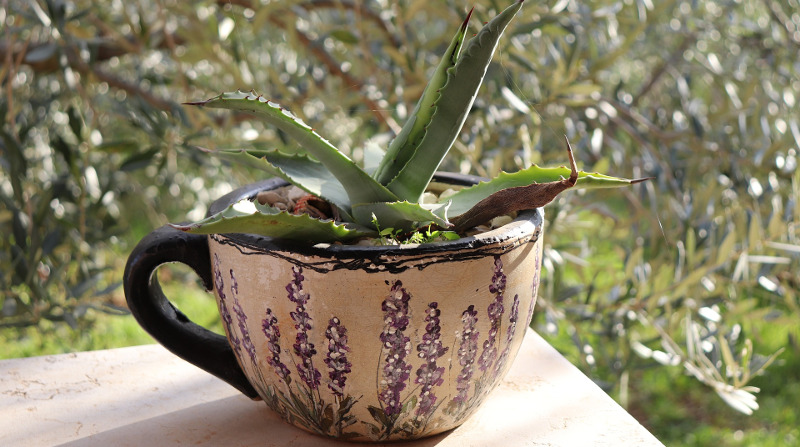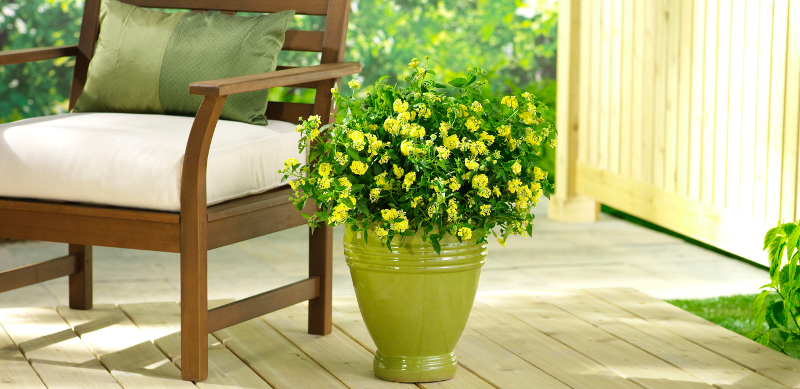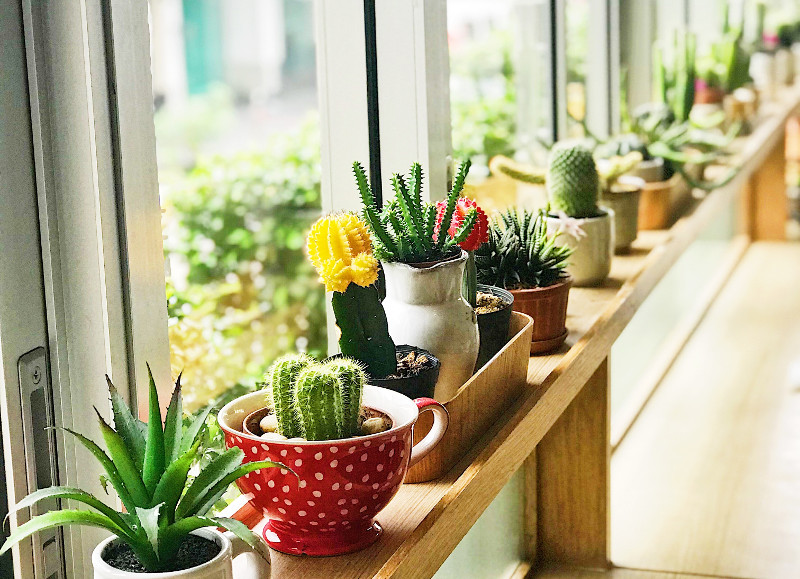We love growing plants in pots! Actually, any kind of container that will hold a plant. We’ve been known to grow herbs in a claw-foot tub and annuals in an old washer. When you grow plants in containers, you increase your flexibility – you can move the container with the sun (maybe not the claw-foot tub so much…) and have color in a shady location by your front door. You also can practice “flower arranger,” creating a few new containers with each season’s annuals, or putting together a group of perennials you can keep outside all year or winter over.
You can also move plants around based on shade and sun exposure or bring some inside for winter. There are plenty of reasons to have lots of fun or decorative containers (or an entire row of them!) Here are a few favorite low-water plants that grow well in containers:
Ornamental Grass

Who says a plant has to flower to look great, especially in a container? We love adding a spike of height and texture with a grass, often in the center or back of a container full of colorful annuals. Most grasses need less water than flowering plants, and they look great blowing in the wind or adding height to a container, especially one placed up against the house. Many of them even flower. Just be sure to check the tag to see how high the grass normally grows before making your purchase.
Rosemary

Rosemary can grow in containers in climates either too cold or too hot for the herb.
Rosmarinus officinalis is our favorite versatile herb that does fantastic in containers. Depending on the look you want, select an upright (bush) type to add height to a mix of xeric container plants or choose a trailing rosemary to drape over the side. Either one should bloom at some point during the growing season. You can move your container rosemary inside to a sunny window or leave outside against a warm south-facing wall for year-round access to the tasty herb. Some varieties can survive winters down to zone 5 or 6, but most do best in warmer climates. And remember, that containers cool off faster than the ground.
Rosemary is equally pleasant smelling and actually edible! The plants also grow as ornamentals in the garden. It has evergreen foliage, so if you live in zones 6 to 8, you probably can keep it alive all year in the garden. In zone 6, it also might make it in a container. So either protect your container or bring it in, depending on the hardiness of the variety you choose. Plant it all alone near your kitchen for easy fresh cuttings, or in a group container.
And if you decide not to take cuttings for cooking, your rosemary might eventually bloom lovely lavender colored blooms. At any rate, put it where you can frequently walk by and just rub your fingers over the leaves.
Verbena (Verbena tenuisecta)

Verbena species vary, but the warm-zone, low-water species can grow with very little water. They came up through the gravel pathways in our rock garden, re-seeding from previous years. I’ve planted small varieties of red, white and rich purple verbena in containers. Once established, verbena will spread and using it in container groupings helps tie them together or add pops of color. Verbena requires no deadheading, though removing spent flowers can prolong the bloom period, which usually runs from spring through frost, depending on your zone.
Chocolate flower (Berlandiera lyrata)
Great in a rock garden or container, a chocolate flower always pleases. And in case you’re wondering, it really does smell like chocolate. I ought to know. Anyway, chocolate flower is a wildflower that produces delicate, daisy-like flowers with a light, almost red, center. Its leaves are a pale, almost silvery green. It’s extremely drought tolerant. Planting it in a container means you can enjoy its scent right on your patio or outside an open window.
Agave

Agave makes a striking single plant.
Pot these upright succulents when you have limited space or your winter low prohibits growing them in the ground. Some agaves become quite large, but probably will grow a little slower in a pot. Try those smaller than about a foot in diameter (basketball-sized at maturity) such as black-spined, artichoke and Queen Victoria for great container-scale plants.
The rosette shape of most agaves makes them perfect as the only plant in a container. Line the top of the soil with decorative rocks or glass and your container design is done! Agaves withstand heat and drought, and some can take cold (such as A. parryi). Most, however, can only handle light freezes.
Portulaca
Portulaca plants are idea for containers, especially for adding texture, draping shape and outstanding color. These grow best in dry, well-draining soil in full sun. Portulaca plants are annuals, but always available in Southwest nurseries. They spread so quickly and bloom so heavily that they are well worth the money.
Choose from bloom colors in reds, oranges, yellows, whites and pink. They often drop tiny seeds that will show up as volunteers the next year, which can be fun. Or you can easily pull up the shallow roots. Portulaca is versatile — you can use one color to excellent effect or add mixes for pops of color in containers.
Lantana

Lantana Yellow is a bright container plant.
These gorgeous plants make great low-growing borders, hedges or potted plants, depending on your climate. Potted lantanas drape over the side, adding shape and dimensions to container arrangements. I love the salmon-pink and lemon-yellow bloom arrangements. Some varieties grow large, but look for dwarf varieties such as Pinkie or Patriot. In the low desert (zones 9 through 11), lantana plants can be outside all year. In high deserts of New Mexico, Arizona and Colorado, we have to grow them as annuals or bring them inside when temperatures dip to about 55 degrees.
Succulents

Happy succulents winter indoors with good southern sun, and travel outside in summer.
Containers dry out faster than the ground, making xeric plants, and especially succulents, the perfect container plants. Succulents need well-draining soil, so look for mixes that don’t retain too much water. Once you get the right soil mix, you should be able to water your succulents lightly once a week and have plenty of success. Most also grow slowly, so they don’t require frequent repotting. Some of my favorites are jade, echeveria, sempervivum, haworthia and crown of thorns.
Tips For Growing Xeric Plants in Containers
- Make sure you have well-draining soil so the roots do not stay too wet.
- Likewise, provide drainage at the bottom of the container.
- Water slowly and lightly when possible to avoid washing out soil and nutrients.
- Most xeric container plants need lots of sun, but keep an eye out for too much sun, especially when moving a plant back outdoors for the summer or placing it inside too close to a window.
- Try to keep xeric plants together in arrangements, since they have similar watering needs. Or if mixing, find a way to separate low-water plants by potting within the larger pot or ensuring water drains away from them.
- Overwatering leads to the demise of more xeric plants, especially container succulents, than other issues.
Remember that plants always need a little more water when you first plant them, in extreme heat and when in containers than when in the ground. Containers usually dry out more quickly than ground soil – how much more depends on the container, soil you used to fill it and the location. And containers are microclimates, which means they might place your plant in colder, warmer or drier conditions than you realize.
 |
Author Teresa Odle - Published 12-10-2020 |
